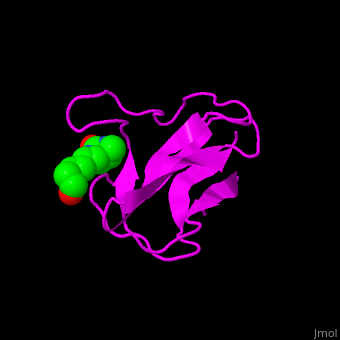Function
Acetyl-CoA carboxylase (ACC) catalyzes the irreversible carboxylation of acetyl-CoA to malonyl-CoA. Malonyl-CoA is a building block in in the biosynthesis of fatty acids. ACC is biotin- and ATP-dependent enzyme. In mammals, 2 forms of ACC exist. ACC1 and ACC2 differ in their tissue distribution and function.
Structural highlights
ACC is a multi-subunit enzyme in prokaryotes and plants. Each subunit catalyzes different reaction. These are – biotin carboxylase (BC) which carboxylates the biotin prosthetic group see Biotin carboxylase, biotin carboxyl carrier protein (BCCP) which is linked covalently to biotin and carboxyltransferase (CT) which transfers the carboxyl group from biotin to acetyl-CoA. In eukaryotes these functions are performed by a single polypeptide chain. The biotindyl domain (residues 891-964 in human) transfers an activated carboxyl group from the BC domain to the CT domain. (1bdo) is shown.
Disease
Bacterial ACC serves as a potential drug target for novel antibiotics.

